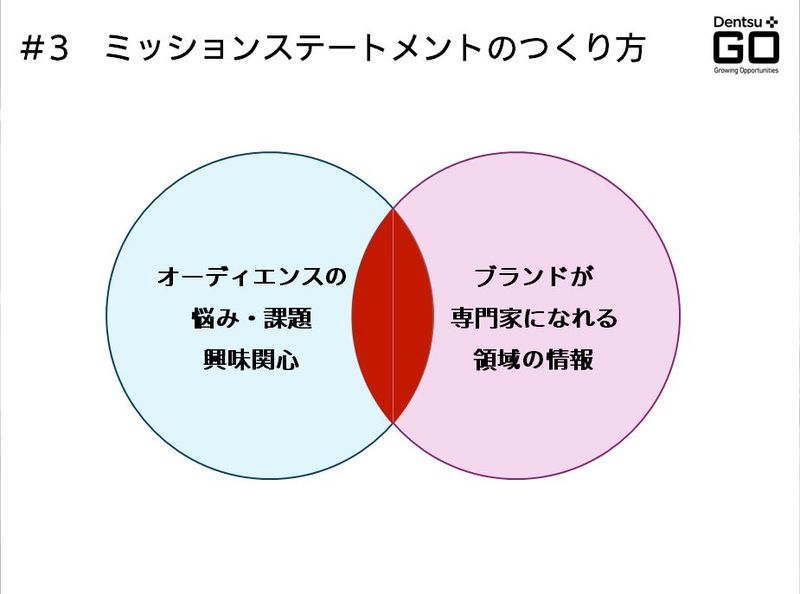In content marketing, marketers must adopt the mindset of an editor. Delivering the information customers seek—content that is valuable and appropriate for them—is crucial. Building on the fundamentals introduced in Part 1, Part 2 features Gunji providing concrete explanations of content marketing practices and outlining the goals achievable through consistent effort.
Five Essential Points for Content Marketing
So, what are the key points for marketers to think like editors? We've summarized five points from the perspective of how this differs from traditional mass media campaigns.
First, content has readers. Advertising targets buyers to communicate product benefits and fulfill their needs. Content marketing, however, not only addresses the need for the product itself but also satisfies the surrounding informational needs. This allows for a broader target audience than just buyers. For example, in housing, targets include people who aren't buying immediately but enjoy looking at various home examples, or those who just want information for the future. To clarify who has what information needs, setting audience personas is essential, just as in advertising. Creating personas requires defining three elements: "Who is this person and what is their typical lifestyle?", "What are their information needs?", and "Why might they be interested in our company or brand?" While this process shares similarities with advertising, it's said that in the social media era, information needs are more effectively reached when targeted more niche. For example, instead of asking "What information do pet owners need?", consider "What information do older people who own pets and want to travel with them need?". You don't need to create many personas. It's sufficient to start by picking a few people most likely to buy and creating personas for them. As you implement this, you'll discover various things that can become hints for the next steps.
The second key point is that content marketing is a long-term, stock-based form of communication. Value and significance grow by consistently "accumulating content," "gathering user data," and "building relationships with consumers." Once you actually start, you'll quickly realize the sheer volume of content needed. Creating original content alone won't suffice, so you must explore diverse production methods: conducting interviews, having users create content, commissioning articles from experts, and more. Content formats also vary widely—blogs, articles, videos, emails, white papers, and so on.

To manage this large volume of content, an editorial calendar is essential. The approach varies depending on the purpose: a strategy-focused calendar might outline which persona each piece targets, its theme, format, keywords, and release date; while a production-focused calendar details which content is created by whom, when, and the timing and channels for distribution. In any case, the crucial elements are regular publication and sustained continuity.
The third point is the need for an editorial policy (mission statement) to unify the brand's personality and the guiding principles for what to offer the audience amidst various content types and creators. The essential elements here are threefold: "Who is the core audience?", "What can be delivered to the audience?", and "What outcomes will the audience gain?". The mission statement serves as a major guiding principle for deciding what to select and what to exclude as various content is planned over the long term. It also becomes the basis for deciding why a specific channel is chosen or why a particular design is selected within concrete content ideas. The mission statement sits at the intersection of the audience's "problems they want solved, challenges, and interests" and "information in areas where the brand can become an expert." If content unrelated to these is being published, it means the mission statement isn't functioning as a filter.

The fourth point is the necessity of planning for content distribution. The fundamental premise is that web content won't reach its target audience simply by being created and left online. While using owned media as the distribution base, methods like leveraging social media as outlets for content distribution and entry points for audiences, or utilizing recommendation systems, can encourage users to navigate content both within and outside owned media, thereby increasing exposure to a larger audience.
Finally, marketing goals. While objectives vary from project to project—ranging from broad goals to immediate, measurable targets—establishing clear goals is paramount. Metrics like page views, unique users, and "likes" are crucial for understanding the current situation, but relying solely on them limits evaluation to individual pieces of content. By accumulating data, you can identify what content is popular and what content people engage with longer. Using this insight to form hypotheses, create subsequent content, and iterate improvements is the essence of content marketing.
Content marketing differs from one-way communication like advertising or mere web content updates. By advancing content marketing—that is, regularly sharing valuable information—a company gradually becomes recognized as one that provides useful insights. Such companies, through continued information sharing, naturally evolve into leaders within their field or industry. Ultimately, they transcend their industry to become opinion leaders in society and the world, constantly attracting attention and commanding respect. This achieves the ultimate differentiation for the corporate brand. Content marketing is a philosophy that holds such a future.




